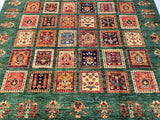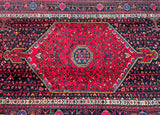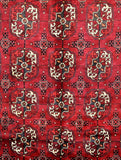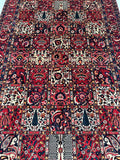Learn About Persian Rugs
Persian Rug Designs and Origin Explained
Persian rug designs and origins explained.
It is impossible to ascertain with any degree of certainty the weaving center in Iran to which a particular carpet belongs. Innumerable small villages, a wide variety of nomadic tribes and now several centers of carpet weaving have merged which makes it difficult to establish with any certainty the origin of a carpet.
The classification of Persian carpets and their connection to one region depends on the form of designs, the kind of colour, wool and the knots, the size, the thickness of the pile, the quantity of the weft, the number of knots and many other particulars.
As mentioned above it is important to familiarize yourself with Persian rug designs, colours and the weaving technics (knots) to determine the origin of a rug.
We have explained in our buyer’s guide to Persian rug blog that all designs can basically be categorized into three principal groups. Geometrical, curvilinear and stylized pattern which is a combination of both.
We can also categorize them into two main groups of Tribal designs and Urban Designs.
In this blog we will go more in depth in regard to the designs and introduce you to the following Persian rug patterns:
Shah Abbasi Design
The Basic Sketch is formed from especially designed flowers, which are known as Shah-Abbasi.
It is set off by other floral designs and occasionally Eslimi motifs, these abstract flowers form the main design in the field and the border, allover (Afshan), medallion, Sheikh safe, tree, animal, turreted medallion are the better known in the secondary group of this design. You can find this pattern mainly in urban rugs from City of Kashan, Isfahan, Tabriz, Mashad and other places.
Arabesque (Eslimi)
Abstract circular branches of a tree amidst leaves are the basic form of this design. The branches are adorned with foliate spurs known as Eslimi. There are many kinds of Eslimi design predominating in some carpets of which the Isfahan rugs are the best Know. Eslimi = Scrolling flower.
Vase (Goldani)
The shape of the vase in different sizes can be seen in the carpet of this category, usually accompanied with tree of life and animal motis. In some large rugs vases are repeated throughout the field of the rug. Mehrabi vase, Zele-e-Sultan vase, Haj Khanumi vase and allover vase fall under this category too.
Harati/Herati Design
This beautiful nomadic design was created in the city of Harat (the capital of Timur) now in Afghanistan.
A Basic sketch is formed from a central diamond shaped figure framed by four slightly curling leaves which could be repeated in the field and the boarder.
Entwined fish (Mahi-dar-ham) pattern is one of the sub-pattern of this category which was produced for the first time in Khorasan but gradually it found its way to other carpet weaving areas of Iran. In past 50 year this pattern has been refined and woven in very fine rugs from city of Tabriz and Bijar and known as fish pattern (Mahi).
Tree – Tree Of Life Design
The base of this design is a tree, sub patterns include tree and animal, floral profusion, vase tree and cypress tree.
Botteh Design (Paisley Pattern)
The botteh design is the abstract form f the cypress tree common in both Indian and Iranian pattern from olden times and for many years it have had a good market. The famous ones of this category are \: Botteh Jegheh,, Botteh Termeh, Bothe Saraband or Botteh Mir, Botteh Ghalamkar Isfahan, Botteh Kurdistani and Botteh Afshari.
Panel Design (Known As Garden Design In Western World)
The field of the carpet in this design is divided by some lateral panels and the carpet looks like a chess-board. The interior of each panel is decorated by the traditional motif of each district such as vase, Botteh, Bunch of grapes, willow, flowers, birds, animals etc.
The design which originally from Bakhtiari area, is appreciated also by the craftsmen of Tabriz, Qum, Birjand. Sub-patterns are Bakhtiari Panel, Eslimi Panel.
Historical Building Design
To create these designs the inspiration has been taken from the tile work and the architecture of the ancient buildings. In the course of history carpet designers have copied the main pattern and created similar designs.
Some of the most famous of the relic are Sheikh Lotf-ollah Mosque, Takhte-Jamshid (Persepolis) and Taghe-Bostan.
Many of finest Tabriz, Qum, Nain and Isfahan dome design rugs fall into this category.
Prayer (Mehrabi) Design
The prayer niche in the mosque where the Imam prays inspires the basic design of the rug. Some ornaments such as columns, headband, candelabrum (Ghadil), Shah Abbasi flowers, may enrich this design. Among the numerous variation are tree prayer, vase prayer, and candelabrum prayer.
Afshan Design
Normally in the carpet design all the component and forms are joined and linked together as if the painter’s pen has never ceased its movement from the beginning until the end of the sketch. In the Afshan design, the flowers, branches and other motifs are scattered on the surface of the carpet without being joined.
Well-known patterns in this group are: Afshan Shah Abbasi, Afshan bouquet of flower and Afshan Gol Farang.
Interconnected (Bandi) Design
When small portion of a design is repeated and connected throught the length and width, the pattern is called interconnected (Bandi).
Sub patterns of this group are known as Bandi Varamin or Mina-Khani, Bandi Eslimi (Arabesque), Bandi Mollah Naserdin, interconnected cartouche.
Striped (Moharamat) Design
The name is applied to designs which are repeated in narrow strips along the length of the carpet. Each strip has its own specific colour and design in some areas of Iran this pattern is also known as Ghalamdani. Botteh Moharamat is one of the sub-pattern of this design.
You may see many more plan or contemporary tribal rugs also have the strip design but without any pattern in the strips.









